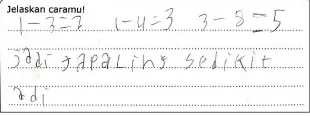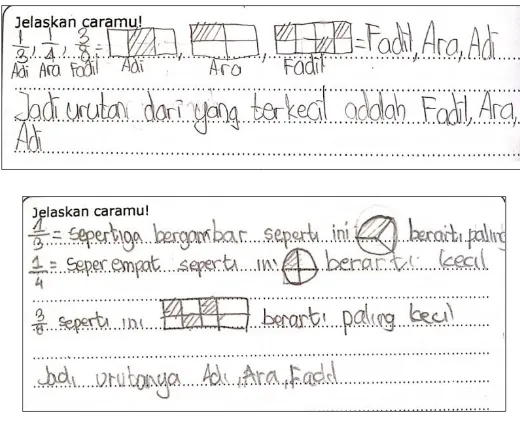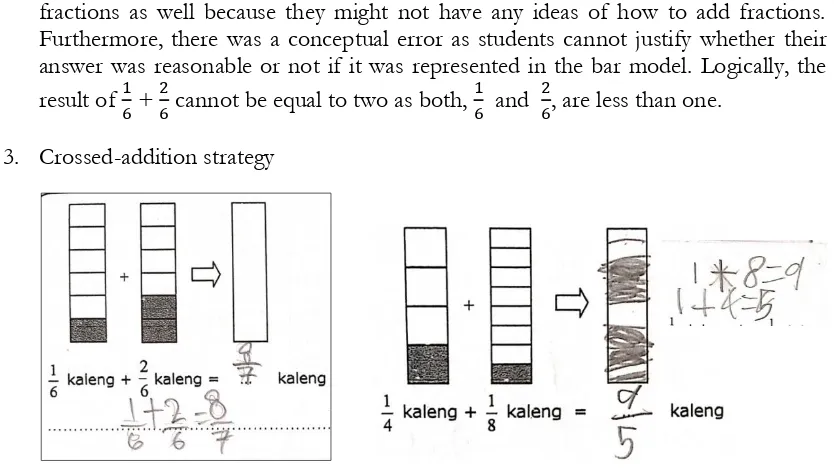131 Journal of Research and Advances in Mathematics Education ISSN: 2503-3697 / e-ISSN: 2541-2590
Vol. 1, No. 2, 131-139, July 2016
http://journals.ums.ac.id/index.php/jramathedu
Identifying Students’ Error
s on Fractions
Herani Tri Lestiana 1), Sri Rejeki 2), Fariz Setyawan 3) 1) Universitas Pancasakti Tegal
2) Universitas Muhammadiyah Surakarta 3) Universitas Ahmad Dahlan
Corresponding author: h.t.lestiana@gmail.com, sri.rejeki@ums.ac.id, fariz.setyawan@pmat.uad.ac.id
Abstract. Many studies have revealed that fraction is a complicated mathematics topic for students. Students struggle to solve problems including comparison and addition of fractions correctly. However, some students often make some common mistakes in solving the mathematics problems. There are three types of errors in solving mathematics problems, which are factual error, procedural error, and computational error. This study was aimed at investigating various mistakes by students in problems related to fractions. A set of validated problems about comparing and adding fractions was assigned to third grade students of SD N Laboratorium Unesa Surabaya. The results indicated that some students were not aware on how to compare and add fractions. Most of these students employed incorrect strategies categorized as procedural and conceptual errors.
Keywords: errors, fraction, factual error, procedural error, computational error
Introduction
The aim of learning mathematics is building students’ knowledge of mathematical
concepts. It is essential for teachers to carry out assessment in order to figure out to what extent students comprehend a given topic. Understanding students’ mistakes in solving mathematical problems gives an insight for teachers about what causes might affect those mistakes and solutions to avoid such mistakes in the future.
Fraction, as revealed by some studies, is considered as challenging topic for students (e.g. Hasemann, 1981; Streefland, 1991; Cramer et al., 2002; van Galen et al., 2008; Charalambous & Pitta-Pantazi, 2007). Many studies suggested some error patterns in some topics in fractions such as interpretations of fractions, comparing fractions, and addition and subtracting fractions. Students have tendency to use rule-based procedure in solving fractions problems without understanding the problems (Howard, 1991).
H.T. Lestiana, S. Rejeki, F.Setyawan/Journal of Research and Advances in Mathematics Education, 2016,1(2), 131-139
132
As an example, as shown by McNamara and Shaughnessy (2011), when students are asked to write the fractions of given shaded area beside, the students answered 1/3. Students already know that the numerator represents the number of shaded parts and the denominator represents the unshaded parts. However, the student couldnot notice that the parts are in different sizes. These mistakes by students might be because teachers
stress more on formal algorithms than on bulding students’ understanding and reasoning
(Idris and Narayanan, 2011). Students’ Mathematical Errors
In solving mathematics problems, both conceptual and procedural knowledge are
needed. Referring to Morales’ study (2014, p. 1), conceptual knowledge refers to
”knowledge of math facts and properties that are recognized as being related in some way”, while procedural knowledge is identified as “is defined as the set of rules and algorithms used to solve math problems”.
As stated by Brown and Skow (2016), students’ errors in mathematics are categorized into three types, which are:
1. Factual mistakes are mistakes made by students as they are short of factual information, such as digit identification.
2. Procedural mistakes are errors caused by inaccuracy in applying mathematical procedure, such as decimal placement.
3. Conceptual mistakes occur when students have misconceptions or misunderstanding about the concepts related to the problem, such as the concept of how to add two fractions.
Cited from Brown and Skow’s paper, the table below explains the examples of each type
of mathematical mistake.
Table 1. Mathematical Errors and Its Examples
Factual Mistakes Examples
Counting errors Miss a number or more in counting: 1, 2, 3, 5 Lack of mathematical terms Students do not know the meaning of
numerator and denominator
Lack of mathematical formulas Students do not know the formula of
H.T. Lestiana, S. Rejeki, F.Setyawan/Journal of Research and Advances in Mathematics Education, 2016,1(2), 131-139
Performing incorrect operations 4 x 5 = 9 Students regard the multiplication as addition
Fraction errors Students cannot find common denominator when adding and subtracting fractions
Misconception of place value 12
9 + 102
Overgeneralization In subtraction, student always put the greater number as the minuend.
10 – 24 = 14 Oversimplification
Right triangle not a right triangle
Aim of the Study and Research Questions
The purpose of this study is to identify third grade students’ errors in solving fractions problems involving comparison of fractions and addition of two fractions. The
findings of this study will help teachers to deal with students’ error and to improve the
instructions in fractions. Thus, this study try to seek this questions What error types do students make in solving problems involving fractions?
Research Method
H.T. Lestiana, S. Rejeki, F.Setyawan/Journal of Research and Advances in Mathematics Education, 2016,1(2), 131-139
134
Results And Discussions
Comparison of Fractions
The problem relating comparison of fractions posed in this study was as follows:
Each Adi, Ara, and Fadil have a piece of bread.
Adi Ara Fadil
Order the children from the one who eats the smallest parts of bread to the one who eats the biggest parts of the bread!
Figure 2. The problem relating comparison of fractions
In this problem, students’ solution were ranged. Most of them use cross-multiplication as below.
Figure 3. Students’ strategy in comparing fractions
In comparing two fractions using that strategy, students multiplied the numerator of one fraction and the denominator of another fractions. The bigger multiplication result is, the bigger the value of the fractions.
However, some students employed some error strategies as following. 1. Subtracting the denominator from the numerator
Figure 4. Students’ error in comparing fractions (1)
In this approach, the student subtracted the numerator by the denominator of each fractions. It can inferred from the picture that students did both procedural and
I eat
3 1
parts of the bread
I eat
8 3
parts of the bread I eat
4 1
H.T. Lestiana, S. Rejeki, F.Setyawan/Journal of Research and Advances in Mathematics Education, 2016,1(2), 131-139
135
factual error. Firstly, he applied incorrect procedure to compare fractions. Secondly, when he subtract 3 from 1, he came to a wrong answer. He answered 2 instead of -2. In this case, he might not be aware of concept of number fact.
2. Using fractions representations to aid solving the problem
Figure 5. Students’ error in comparing fractions (2)
It has been suggested by some studies that utilizing models or representations can help students understand mathematical concept, such as fractions (Cramer et al., 2008; van Galen et al., 2008). However, incorrect concept of how to use the models can be a hindrance in solving problems.
In the picture above, the students tried to use bar and circular models to represent the fractions. Nevertheless, it seemed that they did not aware that the models they used should be in the same shape and size. In the first picture, he used the same model, which was bar model, but he drew them in different sizes. As the result, the student missinterpret which fractions are bigger than the other. Meanwhile, the student of the second picture utilized different kind of models so he could not notice correctly which fractions are bigger than the other.
Addition of Fractions
H.T. Lestiana, S. Rejeki, F.Setyawan/Journal of Research and Advances in Mathematics Education, 2016,1(2), 131-139
136 1. ‘Top+top and bottom+bottom’ strategy
Figure 6. Students’ error in adding fractions (1)
Simply adding the tops (numerators) together and the bottoms (denominators) together is the most common mistake by students in solving addition of fractions (Howard, 1991; Young-Loveridge, 2007). In the examples shown above, the students obtain the result of fractions addition problem by employing that strategy. Thereafter, they transferred the answer in the bar model available. Eventhough the result illustrated in the bar model is clearly confirmed that it was not reasonable, the students kept on their answer as they were lack of conceptual knowledge about the reasoning in adding fractions. For instance, when adding 2
3 by 1
4, the answer must be
more than a half since 23 itself is more than a half. Moreover, it seemed that they apply this strategy since they refer to addition of non-fractional numbers. Thus, they operated this procedural error.
2. Crossed-Multiplication Strategy
Figure 7. Students’ error in adding fractions (2)
As can be seen in the picture, the students multipied the numerator of one fraction by the denominator of another fraction. Then, they put one of the multiplication result as the numerator and another as the denominator.
H.T. Lestiana, S. Rejeki, F.Setyawan/Journal of Research and Advances in Mathematics Education, 2016,1(2), 131-139
137
fractions as well because they might not have any ideas of how to add fractions. Furthermore, there was a conceptual error as students cannot justify whether their answer was reasonable or not if it was represented in the bar model. Logically, the result of 1
6 + 2
6 cannot be equal to two as both, 1 6 and
2
6, are less than one.
3. Crossed-addition strategy
Figure 8. Students’ error in adding fractions (3)
In this strategy, firstly they added the numerator of one fraction by the denominator of another fraction. Afterward, they put the result as the numerator while the other was put as the denominator. Similar with the previous type of error, the students tried to immitate the strategy they used in comparing fractions. However, as they were aware that the problems were about addition, they adapted the strategy by adjusting the operation from crossed-multiplication to crossed-addition.
4. Incorrect utilisation of bar model
Figure 9. Students’ error in adding fractions (4)
H.T. Lestiana, S. Rejeki, F.Setyawan/Journal of Research and Advances in Mathematics Education, 2016,1(2), 131-139
138
Conclusion
Most mistakes employed by students in this study are procedural and conceptual mistakes. Some students did not know how to compare and add fractions; thus they applied any procedures they were familiar with. Those mistakes included inaccurate use
of models, ‘top+top and bottom+bottom’ strategy, crossed-multiplication, and crossed-addition strategy. Some studies suggested that mathematical errors occured as teachers focused more on formal algorithm than on understanding underlying reasoning behind the concept (Lamon, 2001; Idris and Narayanan, 2011). Thus, in the future, teachers
should put more emphasize on students’ understanding and reasoning to avoid such mistakes.
References
Brown, Janice and Skow, Kim. (2016). Mathematics: Identifying and Addressing Student
Errors. Retrieved from
http://iris.peabody.vanderbilt.edu/case_studies/ics_matherr.pdf.
Charalambous, C. Y., & Pitta-Pantazi, D. (2007). “Drawing on a Theoretical Model to
Study Students’ Understandings of Fractions”.Educational Studies in Mathematics,
64(3), 293-316.
Cramer, K. A., Post, T. R., & delMas, R. C. (2002). “Initial Fraction Learning by Fourth- and Fifth-Grade Students: A Comparison of the Effects of Using Commercial
Curricula with the Effects of Using the Rational Number Project Curriculum”.
Journal for Research in Mathematics Education, 111-144.
Cramer, K., Wyberg, T., & Leavitt, S. (2008). “The Role of Representations in Fraction
Addition and Subtraction”.Mathematics Teaching in the Middle School, 13(8), 490-496.
Hasemann, K. (1981). “On Difficulties with Fractions”.Educational studies in mathematics,
12(1), 71-87.
Howard, A. C. (1991). “Addition of Fractions—The Unrecognized Problem”.The Mathematics Teacher, 84(9), 710-713.
Idris, Noraini and Narayanan, Latha Maheswari. (2011). “Error Patterns in Addition and
Subtraction of Fractions among Form Two Students”. Journal of Mathematics Education, 4(2), 35-54.
Lamon, S. J. (2001). “Presenting and Representing: From Fractions to Rational
Numbers”.The Roles of Representation in School Mathematics, 41-52.
McNamara, Julie and Shaughnessy, Meghan M. (2011). Student errors: What can they tell us about what students DO understand?. Mathsolutions.com.
Morales, Zoe A. (2014). Analysis of Students’ Misconceptions and Error Patterns in Mathematics: The Case of Fractions. Education Commons. Retrieved from http://digitalcommons.fiu.edu/cgi/viewcontent.cgi?article=1350&context=sfer c.
Streefland, L. (Eds). (1991). Fractions in Realistic Mathematics Education: A Paradigm of Developmental Research, 8. Springer.
H.T. Lestiana, S. Rejeki, F.Setyawan/Journal of Research and Advances in Mathematics Education, 2016,1(2), 131-139
139
Young-Loveridge, J., Taylor, M., Hàwera, N., & Sharma, S. (2007). “Year 7–8 Students’



